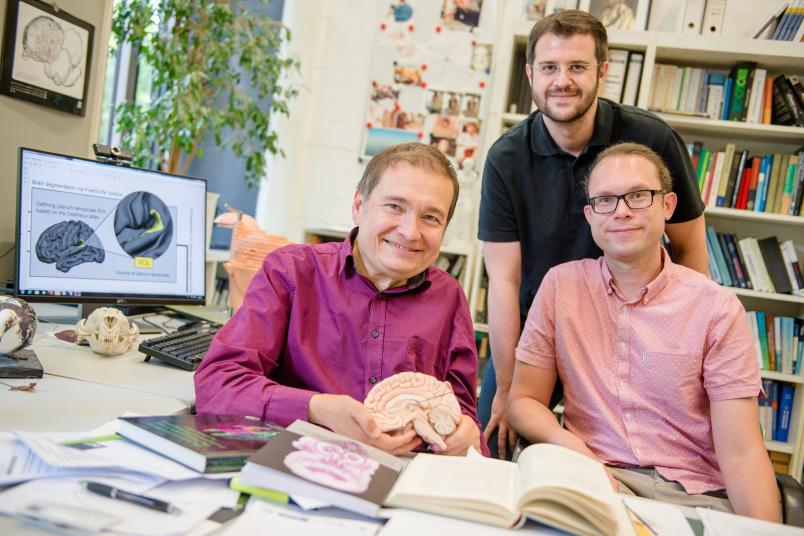
Brain functions Why the left hemisphere understands language better than the right
New imaging technologies facilitate insights into the microstructure of critical areas of the brain that had not been possible in the past.
Nerve cells in the brain region planum temporale have more synapses in the left hemisphere than in the right hemisphere – which is vital for rapid processing of auditory speech, according to the report published by researchers from Ruhr-Universität Bochum and Technische Universität Dresden in the journal “Science Advances”. There has already been ample evidence of left hemisphere language dominance; however, the underlying processes on the neuroanatomical level had not yet been fully understood.
A new form of magnetic resonance imaging (MRI) in combination with electroencephalography (EEG) measurements has made it possible to bundle insights into the microstructure of planum temporale with the speed of auditory speech processing. The team headed by Dr Sebastian Ocklenburg, Patrick Friedrich, Christoph Fraenz, Prof Dr Dr h. c. Onur Güntürkün and Dr Erhan Genç outlines their findings in an article published in the scientific journal Science Advances from July 11, 2018.
Left hemisphere language dominance
Using a simple experiment, researchers can demonstrate just how superior the left hemisphere is when it comes to the processing of auditory speech: when playing two different syllables – for example “Da” and “Ba” – to a person’s left and right ear via headphones, most people will state that they only heard the syllable in the right ear. The reason: language that is perceived via the right ear is processed in the left hemisphere. When brainwaves are measured using EEG, it emerges that the left hemisphere processes auditory speech information more rapidly.
“Researchers have long determined that a brain region that is crucial for the processing of auditory speech, i.e. planum temporale, is frequently larger in the left hemisphere than in the right one,” says Sebastian Ocklenburg from the biopsychology research unit in Bochum. In the brains of deceased individuals who had donated their bodies to science, Frankfurt-based researchers later discovered that the nerve cells in the left planum temporale have a larger number of neuronal synapses than those in the right hemisphere.
New measurement method facilitates hitherto impossible insights
“However, it had previously not been understood if that asymmetrical microstructure is the decisive factor for the superiority of the left hemisphere when it comes to the processing of auditory speech,” explains Erhan Genç, likewise a member of the biopsychology research unit. Since a method for counting the number of neural synapses in living humans had not existed until very recently, that number could not be conclusively linked to the performance of auditory speech processing. The researchers have now closed this gap with the aid of so-called neurite orientation dispersion and density imaging.
By deploying this highly specific MRI technology, the bio-psychologists measured the density and spatial arrangement of planum temporale neurites in almost one hundred test participants. At the same time, they used EEG measurements to analyse the processing speed of auditory speech information in both the left and the right hemispheres in the same individuals.
Higher speed thanks to more neurites
The result: test participants who were capable of processing auditory speech in the left hemisphere at a high speed possessed an extraordinarily high number of densely packed neurites in the left planum temporale. “It is because of this microstructure that processing of auditory speech is faster in the left hemisphere; those individuals are presumably also able to decode what they hear at higher temporal precision,” concludes Ocklenburg. “Higher connectivity density thus appears to be a crucial component for the linguistic superiority of our left hemisphere,” adds Genç.